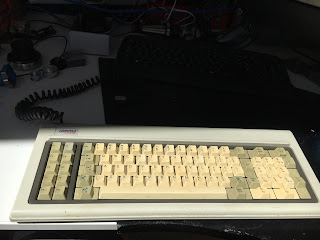I upgraded mine to the full 640k RAM (!!!!) and inserted a 30MB (!!) Western Digital Filecard (aka Hardcard). I was able to run Norton Commander, Norton Utilities, Sidekick and World Golf. At one point my dad acquired a dial up modem from an auction - IIRC, this was a Hayes 1200 baud(!!) Smartmodem. There wasn't much out there in those days but I recall connecting to Dr Soloman's BBS. Finally, I splashed out on a Naksha serial mouse. Along with Norton Commander, I had an almost-GUI experience!
Rightly or wrongly, about 25 years ago, I scrapped the thing, along with an original IBM AT, as they were both pretty much obsolete. But I kept the Hardcard and a load of the 5.25" floppies.
About 5 years ago, I found a very similar machine on ebay. Didn't cost much, although I forget how much. Apart from the fact that it's a 120V machine (I bought it when I lived in Canada, from a guy in the US), it seems a good 'un.
Here's what it looks like:
But that bottom panel is actually a keyboard and it also reveals the screen (green monochrome) and twin 5.25" floppy drives.
The side panels simply clip on and off, revealing a sheet loominum chassis:
This is actually a memory expansion board:
The hardcard seems to have a datecode of 1988.
I have a US style IEC lead, to help me to remember to plug into the 120V supply. If I plug into 240V, the PSU will pop.
And the DIR command shows the files and folders on the A: system floppy:
The filecard is mapped as C:
But......I can't type an "N", so it's not possible to run Norton Commander, or even to change to the NORTON directory. There's a simple reason for that....
Looks as if the last time I used this was in December 1993.
Under the other ("bottom") side cover, there's a cover plate (top RHS):
The keyboard cable comes up a loominum tube and plugs into the motherboard in a shielded connector (top of pic). A simple Tyrap cable tie formed a cable anchor.
There - keyboard removed:
Cover off:
PCBA removed from housing. Date codes suggest late 1985, most likely 1986
Underside:
It's a capacitive system. Those little pads cause a capacitive shunt across the PCB contacts.
But the metalised plastic film is losing its metalisation:
This one is actually the "N" key. I know that one doesn't work and indeed there is almost no metalisation left at all.
This is what a slightly better one looks like:
Luckily, someone's been here before:
8-Bit Guy's Compaq Portable resurrection video 1
8-Bit Guy's Compaq Portable resurrection video 2:
The 8-Bit Guy had all the problems, from floppy, graphics board, keyboard etc. My machine just works, even after 25 years.
But what I've learned from these videos is that it's possible to obtain replacement pads from TexElec, so there won't be any need to piss about with films and glue. So I've ordered a set of those.
He also mentions products such as a 1MB RAM board and upgrades such as CF (flash) board that will sit on an ISA bus. I guess this will provide similar functionality to the 30MB Hardcard, so I ordered one of those. However, the original UK developer Lo-Tech products (James Pearce) seems to have handed off sales of the products to a US outlet. And worse than that, they have nil stock. So instead I got a similar retro product from AA Pro Ltd. This claims to have a boot ROM and an IDE interface, allowing you to boot from an IDE-connected storage device. Who knows, that may be useful.
There's a useful forum for retro-minded PC nerds - 8-Bit Guy forum for retro computer stuff. Bizarrely, its address is murray2.com but I can get over that.
Finally, I ordered some 12% hydrogen peroxide, so I can get rid of the discolouration of the (originally) white plastic. The discolouration is caused by bromine in the plastic and can be reversed using peroxide, as explained in the second video. Seems you can't simply buy 12% peroxide in a pharmacy these days due to terror concerns, although you'd be hard pushed to make an explosive device using 12% peroxide.
For now, I await the peroxide and the keyboard pads....


































No comments:
Post a Comment